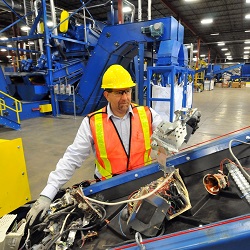 While there are several actions you can take to help preserve the environment, the responsible disposition of IT and electronic equipment (e-waste) continues to be a crucial one that must be managed properly. Identified as the fastest-growing waste stream, electronic devices contain hazardous materials and have a high device turnover rate as new products are constantly introduced into the market. Some savvy IT managers or device owners will sell or trade-in their replaced electronics ensuring they receive the highest value possible. While others let their items sit in storage, losing value day by day.
While there are several actions you can take to help preserve the environment, the responsible disposition of IT and electronic equipment (e-waste) continues to be a crucial one that must be managed properly. Identified as the fastest-growing waste stream, electronic devices contain hazardous materials and have a high device turnover rate as new products are constantly introduced into the market. Some savvy IT managers or device owners will sell or trade-in their replaced electronics ensuring they receive the highest value possible. While others let their items sit in storage, losing value day by day.
What you may wonder is what happens to these devices once they’ve surpassed their reuse potential. When an item is either unusable or past the point of holding any resale value, end-of-life recycling must occur to break down the device and return it back to raw commodity form. The process sounds simple but is actually very complex as each brand of electronic device manufactured today is uniquely made out of different materials.
Therefore these frequently asked questions should help breakdown the process that occurs within most recycling facilities from arrival to departure.
[bctt tweet=”These frequently asked questions should help breakdown the process that occurs within most recycling facilities” via=”no”]
How is e-waste collected and transported?
IT and electronic equipment is generally collected in bulk, packed and palletized to prepare for secure transportation to the nearest facility for further processing. In general most items are received from businesses or manufacturers, even if they are consumer items. Manufacturers typically have trade-in or recycling programs that help them collect these devices back after being sold to ensure they’re being responsibly managed in the end.
How do you know your data stored on each device isn’t going to be exposed?
There are IT asset disposition companies who have security requirements and standards in place for handling warehousing and transportation of goods to protect the data stored but regardless, it is always recommended to take extra precautions to ensure the security of your information prior to handing over your personal or corporate devices.
For companies holding highly-sensitive data, there are on-site services available where items can be physically destroyed before leaving your office. This is recommended when dealing with large quantities of media storage devices because it can be done efficiently and will leave you with the opportunity to not only view the destruction, but also know it is being managed in accordance with applicable standards and regulations. You will most likely receive the documentation proving the service was completed as well, which will help when dealing with compliance audits.
Once material is received at the recycling facility, what happens to it?
Upon arrival electronics are weighed, verified, entered in a tracking system, and tested for reuse, resale or recycling. Materials can arrive in various mixes, shapes and sizes. Sometimes they arrive in their original packaging and other times facilities receive only separated component parts. It is then left to the IT asset disposition vendor to manually sort through and manage each item individually to ensure maximum value recovery.
Once obsolete items are inspected, sorted and separated they are sent to a shredding system to be broken down into raw commodities.
Why can’t all items be shredded? Why do they need to be inspected first?
Items can’t be placed directly into the shredder due to the hazardous and potentially flammable components within each device. Focus materials such as batteries, mercury-containing devices, cathode-ray-tube (CRT) glass, and toner are removed manually to ensure safe and environmentally responsible processing.
Depending on the size and capacity of the shredder being used, the shredding and destruction process must be monitored carefully to ensure no materials jam the shredder to avoid causing any disruption. Shredded materials are then sorted and separated into commodities such as plastic, copper, glass and aluminum.
After e-waste is shredded and separated, how is it reused?
Once commodities are separated, the materials of value are sent to downstream vendors for reuse. Refined commodities are then sold to manufacturers to be made into new products.
Overall, the process of e-waste disposition is comprehensive involving custom equipment and manual labor. Most legitimate recyclers who are actually processing the material must perform in accordance with local, regional and international regulations, as well as uphold industry certifications to stay competitive. If you’re searching for a vendor to use, it is recommended to perform your due diligence to ensure your electronic devices, and the data residing on them, are managed in a secure and environmentally responsible manner.
Learn more about electronics recycling programs available.